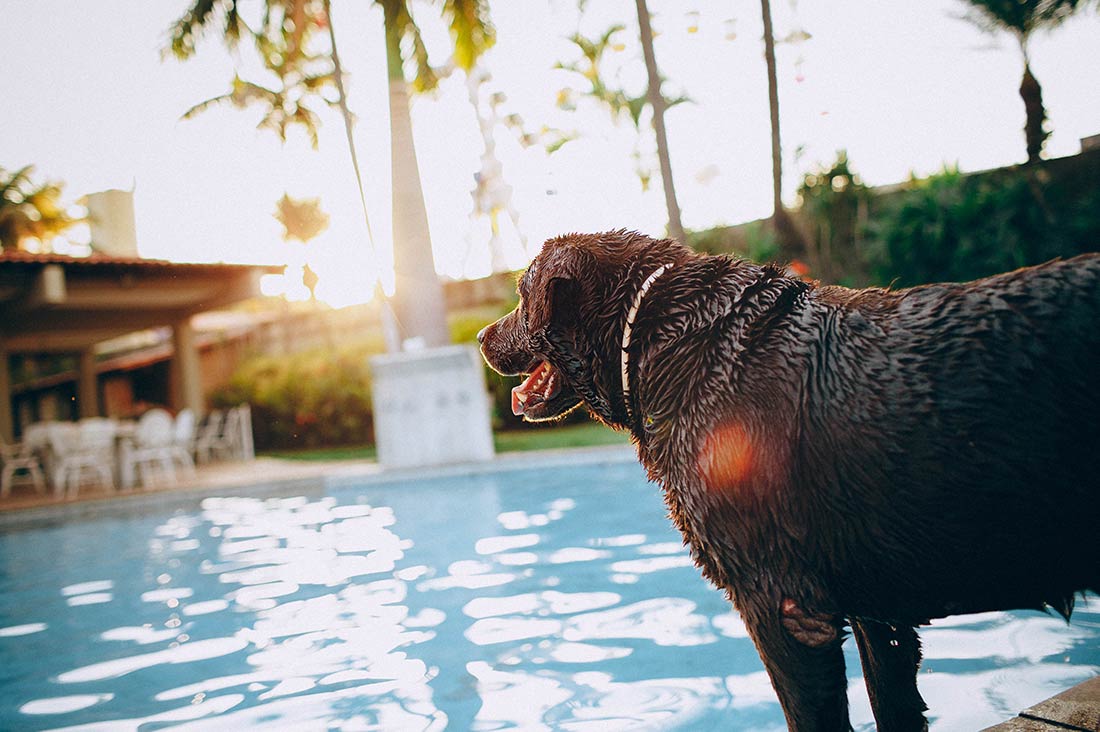Is It Safe For My Dog To Swim In My Pool?
Is there anything cuter than your adorable puppy jumping snout-first into the beautiful, shimmering waters of your fibreglass pool? Well, now you can enjoy that feeling to its fullest by knowing that your dog will be safe to swim in your pool! Provided, of course, that you follow these guidelines to maximise their safety and that of your pool and other swimmers! Read on to figure out what you need to do for a worry-free pup-swimming experience.

How To Check If Your Dog Is Safe To Swim First
The first step in your preparation begins with – and you may have guessed this already – your dog! Yes, before you go taking your four-legged friend for a quick dip, it’s your responsibility to check in with them first?
Okay, so we don’t mean actually talk to them (although we won’t blame you if you do) but instead, do a thorough check of their swimming capabilities.
Is your dog a capable swimmer? Do they love the water or does he/she shy away from water constantly? If your canine friend is eager to jump in the pool, then you don’t need to worry. But forcing your dog to swim when they don’t want to is never a good idea – for them or you. Additionally, you will want to keep an eye on your dog’s behaviour once they enter the water. Some dog breeds are born swimmers, while others struggle immensely with large pools. If your dog is small, has stumpy legs or has a flat snout that indicates breathing troubles, it’s a good idea to stay near them in the water at all times.
What Are The Effects Of Chlorine On Your Dog?
This is one of the most common questions we receive here at The Fibreglass Pool Company and for good reason. Chlorine is not a chemical that dogs will naturally come into contact with – except when they swim in your pool.
The good news is that chlorine will not negatively affect your dog on its own. Think about it in terms of a human swimming in your pool. The chlorine will not affect the human, but a chlorine imbalance may cause skin (or in this case fur) irritation, especially around the eyes.
You should also keep an eye out in case your dog swallows any pool water. This can cause them to retch and vomit if they have swallowed too much pool water.
Otherwise, chlorine is safe for your dog, as long as the chemical balance is kept and your dog does not swallow any pool water.
We highly recommend rinsing your pet off with clean water from a hose to get rid of any chlorine that sticks to their fur. You should then dry them with a towel. Another thing you should do is keep a bowl of clean, safe-to-drink water near the pool while your dog swims, in case they get thirsty.

Keep An Eye Out For Your Dog’s Nails
Another important thing to add to your dog-swimming safety checklist is to first check the length of their nails. This may come as a surprise, but your dog swimming may become a hazard for you, rather than themselves.
This is because dogs are prone to becoming rather excited when they swim. They may not realise that their nails can hurt you, especially when they are focusing on staying afloat. More often than not, a dog will seek you out when they are swimming and try to make their way to you excitedly. If their nails are particularly long and sharp, they can easily harm your skin and leave behind scars.
You should be especially aware of this if you are planning on having your dog swim in any pool with children.
What Does Your Dog Swimming Mean For Your Pool?
Now that we’ve gotten the dog’s safety concerns out of the way, it’s time to think about the concerns facing your pool!
That’s right, believe it or not, but your dog may be affecting your pool negatively – not the other way around.
Experts suggest that one dog is equal to up to three human beings in your swimming pool! This is because dogs are naturally dirtier than people: any dirt they pick up on their paws or in their fur will be deposited in your pool. In addition to this, a dog’s fur is far more prone to shedding than human hair, and due to its size can easily clog your pool filter.
The rule of thumb is: always check your pool’s chemical balance after a dog has been swimming in it. This includes the Ph levels and alkalinity.
Your pool will most likely require an additional chlorine dose afterwards to help deal with all the added dirt. Lastly, use a skimmer to clean out all the dog hair left behind – some of this will clump together days after the swim.
To recap: it is absolutely safe for your dog to swim in your fibreglass pool. Provided, of course, that you keep an eye on them clean them off afterwards. It is not safe for them to ingest pool water, however, and they may dirty up your pool. But before you can worry about all that, there is one last thing you will need to check: which fibreglass pool you’re going to buy! Here at The Fibreglass Pool Company, our amazing range of award-winning fibreglass pools can accommodate weekends full of fun – for your family and your dog! So head over to our pool ranges today to find yours!
